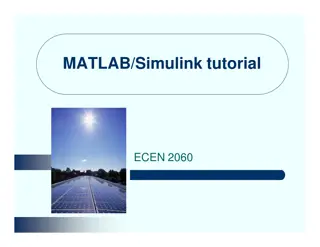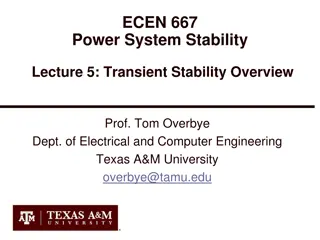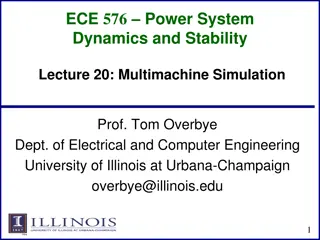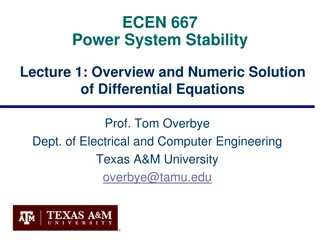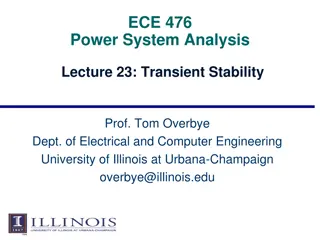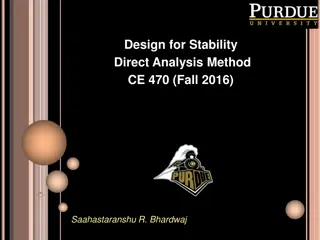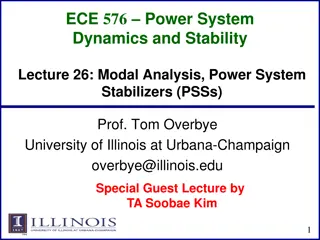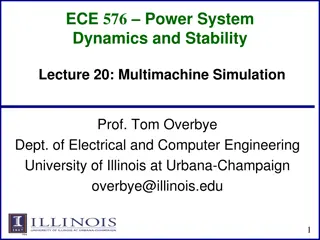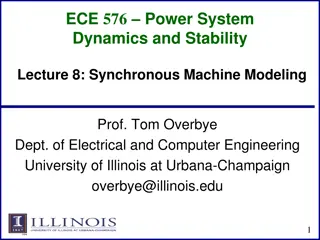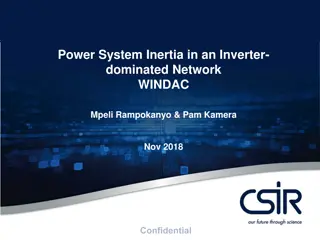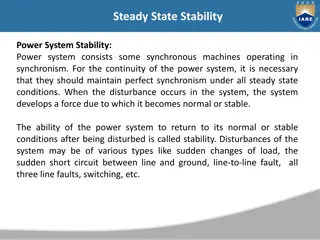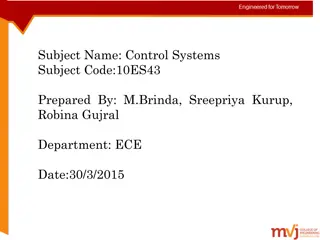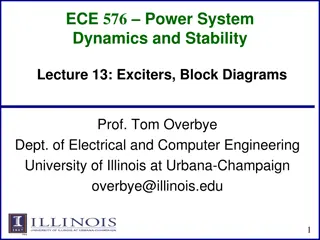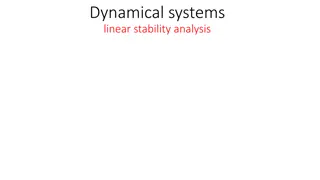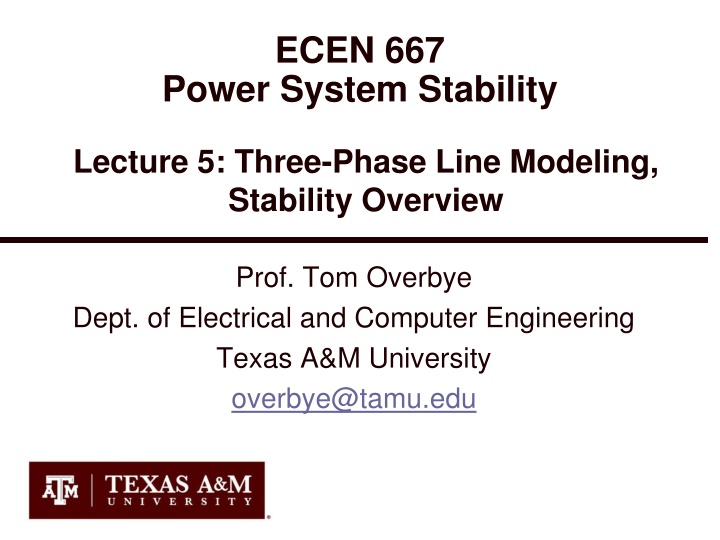
ECEN 667 Power System Stability
This lecture covers modeling of three-phase lines, stability analysis, lumped capacitance model, and resistive & inductive properties. Explore circuit models, transmission line resistance calculations, and per-phase parameters derivation in a power system context.
Download Presentation

Please find below an Image/Link to download the presentation.
The content on the website is provided AS IS for your information and personal use only. It may not be sold, licensed, or shared on other websites without obtaining consent from the author. If you encounter any issues during the download, it is possible that the publisher has removed the file from their server.
You are allowed to download the files provided on this website for personal or commercial use, subject to the condition that they are used lawfully. All files are the property of their respective owners.
The content on the website is provided AS IS for your information and personal use only. It may not be sold, licensed, or shared on other websites without obtaining consent from the author.
E N D
Presentation Transcript
ECEN 667 Power System Stability Lecture 5: Three-Phase Line Modeling, Stability Overview Prof. Tom Overbye Dept. of Electrical and Computer Engineering Texas A&M University overbye@tamu.edu
Announcements Homework 1 is due on Thursday September 16 Starting read Chapter 3 Reference for modeling three-phase lines is W. Kersting, Distribution System Modeling and Analysis, 4th Edition, CRC Press, 2018 1
Lumped Capacitance Model The trapezoidal approach can also be applied to model lumped capacitors ( ) ( ) i t C dt dv t = Integrating over a time step gives 1 C + t t + + = ( ) ( ) v t ( ) i t v t t t Which can be approximated by the trapezoidal as ( ( ) ( ) ( v t t v t i t 2C t ) + = + + + ) ( ) i t t 2
Lumped Capacitance Model t ( ) + = + + + ( ) ( ) v t ( ) ( ) i t v t t i t t 2C t + ( ) ( ) v t t 2C v t + = ( ) ( ) i t i t t t 2C Hence we can derive a circuit model similar to what was done for the inductor ( ) v t t 2C This is a current source that depends on the past current and voltage values ( ) i t 3
Example 2.1: Line Closing Note this is v3(ti) = v2(ti) - 400*i2(ti) Note we have two separate circuits, coupled together only by past values 4
Modeling Transmission Lines Undergraduate power classes usually derive a per phase model for a uniformly transposed transmission line 0 ln 2 10 2 2 C D R D R D R 7 = = m m ln H/m L b b = ln m c b 1 13 = = n D (r' ) ab ac bc d d d R d d m 12 b 1 n 1 c b = n R ( ) (note r NOT r') rd d 12 1 n -12 = = in air 8.854 10 F/m o 5
Modeling Transmission Lines Resistance is just the per unit length times the length Calculate the per phase inductance and capacitance per km of a balanced 3 , 60 Hz, line with horizontal phase spacing of 10m using three conductor bundling with a spacing between conductors in the bundle of 0.3m. Assume the line is uniformly transposed and the conductors have a 1.5 cm radius and resistance = 0.06 /km 6
Modeling Transmission Lines 13 ( ) = 10 10 20 = D 12.6m m 13 ( ) = = 0.78 0.015 0.3 0.3 12.6 2 10 ln 0.102 0.102m R b 7 -7 -4 = =9.63 10 H/m = 9.63 10 H/km L 13 ( ) c b = 0.015 0.3 0.3 = 0.1105m R -12 2 8.854 10 12.6 0,1105 -11 -8 = = 1.17 10 F/m = 1.17 10 F/km C ln Resistance is 0.06/3=0.02 /km Divide by three because three conductors per bundle 7
Untransposed Lines with Ground Conductors To model untransposed lines, perhaps with grounded neutral wires, we use the approach of Carson (from 1926) of modeling the earth return with equivalent conductors located in the ground under the real wires Earth return conductors have the same GMR of their above ground conductor (or bundle) and carry the opposite current Distance between conductors is Note this depends on frequency! = . m D 658 5 f ' kk where is the earth resistivity in -m with 100 -m a typical value 8
Untransposed Lines with Ground Conductors The resistance of the equivalent conductors is Rk'=9.869 f /m with f the frequency, which is also added in series to the R of the actual conductors Conductors are mutually coupled; we'll be assuming three phase conductors and N grounded neutral wires Total current in all conductors sums to zero 9
Untransposed Lines with Ground Conductors The relationships between voltages and currents per unit length is Aa E E E 0 I I I I a Bb b ( ) = + Cc c R L j n1 0 InN Where the diagonal resistance are the conductor resistance plus Rk' and the off-diagonals are all Rk' The inductances are with Dkk just the GMR for the conductor (or bundle) D D 2 10 = 7 ln ' km L Dkk' is large so Dkm' Dkk' km km 10
Untransposed Lines with Ground Conductors This then gives an equation of the form Which can be reduced to just the phase values = = 1 E Z Z Z Z I Z I p A B D C p p p We'll use Zp with symmetrical components 11
Example (from 4.1 in Kersting Book) Given a 60 Hz overhead distribution line with the tower configuration (N=1 neutral wire) with the phases using Linnet conductors and the neutral 4/0 6/1 ACSR, determine Zp in ohms per mile Linnet has a GMR = 0.0244ft, and R = 0.306 /mile 4/0 6/1 ACSR has GMR=0.00814 ft and R=0.592 /mile Rk'=9.869 f /m is 0.0953 /mile at 60 Hz Phase R diagonal values are 0.306 + 0.0953 = 0.401 /mile The neutral R values are 0.592 + 0.0953 = 0.6873 /mile https://encrypted-tbn1.gstatic.com/images?q=tbn:ANd9GcTJ2Gz0Cy2OqakFjGU0oJWalOlQL_uJSEqob28sFxQc49ohH9Xo Figure 4.7 from Kersting 12
Example (from 4.1 in Kersting Book) Example inductances are worked with = 100 -m 100 = = = . . ft D 658 5 m 850 1m 2789 60 D D ' kk D D 2 10 = 2 10 7 7 ln ln ' ' km kk L km km km Note at 2789 ft, Dkk' is much, much larger than the distances between the conductors, justifying the above assumption 13
Example (from 4.1 in Kersting Book) Working some of the inductance values 2789 0 0244 Even though the distances are worked here in feet, the result is in H/m because of the units on 0 2 10 = = 7 6 ln . H/m L 2 329 10 aa . Phases a and b are separated by 2.5 feet, while it is 5.66 feet between phase a and the ground conductor 2789 2 5 2789 5 66 2 10 = = 7 6 ln . H/m L 1 403 10 ab . 2 10 = = 7 6 ln . H/m L 1 240 10 an . 14
Example (from 4.1 in Kersting Book) Continue to create the 4 by 4 symmetric L matrix Then Z = R + j L + + + + + + + + + + + + + + + + . . . . . . . . . . . . . . . . . . . . . . . . . . . . . . . . 0 4013 0 0953 0 0953 0 0953 j1 4133 j0 8515 j0 7266 j0 7524 0 0953 0 4013 0 0953 0 0953 j0 8515 0 0953 j1 4133 j0 7802 j0 7865 j0 7266 j0 7802 j1 4133 j0 7674 0 0953 0 0953 0 0953 0 6873 j0 7524 j0 7865 j0 7674 j1 5465 0 0953 0 4013 0 0953 = Z Partition the matrix and solve The result in /mile is + = + + = 1 Z Z Z Z Z p A B D C + + + + + + . . . . . . . . . . . . . . 0 4576 0 1560 0 1535 1 0780 j0 5017 j0 3849 0 1560 0 4666 0 1580 j0 5017 j1 0482 j0 4236 0 1535 0 1580 0 4615 j0 3849 j0 4236 j1 0651 Z . . . . p 15
Modeling Line Capacitance For capacitance the earth is typically modeled as a perfectly conducting horizontal plane; then the earth plane is replaced by mirror image conductors If conductor is distance H above ground, mirror image conductor is distance H below ground, hence their distance apart is 2H In 667 you don t need to know how to do line capacitance 16
Modeling Line Capacitance The relationship between the voltage to neutral and charges are then given as nN nN km kn m m km m a m a km 2 D H 1 P 2 D H 1 = = ln V q q P = = = ln km km km P's are called potential coefficients Where Dkm is the distance between the conductors, Hkm is the distance to a mirror image conductor and kk D = c b R
Modeling Line Capacitance Then we setup the matrix relationship And solve = 1 V P P P P Q p A B D C p 1 = 1 C P P P P p A B D C 18
Continuing the Previous Example In example 4.1, assume the below conductor radii For the phase conductor R 0.0300 ft b = = c c n For the neutral conductor R 0.0235 ft Calculating some values = = F/mile 12 2 . F/m . 8 85 10 1 424 10 = = = 0 . . 1 2 29 0 0 0300 2 29 0 0 0300 = = ln . ln . mile/ F P 11 177 84 57 aa . . 2 0 . . . 58 05 2 5 54 148 5 6569 = . ln . mile/ F P 11 177 35 15 ab = . ln . mile/ F P 11 177 25 25 an . 19
Continuing the Previous Example Solving we get . . . . . . . . . 77 12 26 79 15 87 26 79 75 17 19 80 15 84 19 80 76 29 = = 1 P P P P P mile/ F p A B D C . . . . 0 0150 0 0049 0 0018 0 0049 0 0158 0 0030 0 0018 0 0030 0 0137 1 = = C P . . . F/mile p p . . 20
Frequency Dependence We might note that the previous derivation for L assumed a frequency. For steady-state and transient stability analysis this is just the power grid frequency As we have seen in EMTP there are a number of difference frequencies present, particularly during transients Coverage is beyond the scope of this class An early paper is J.K. Snelson, "Propagation of Travelling on Transmission Lines: Frequency Dependent Parameters," IEEE Trans. Power App. and Syst., vol. PAS-91, pp. 85-91, 1972 21
Power System Overvoltages Line switching can cause transient overvoltages Resistors (200 to 800 ) are preinserted in EHV circuit breakers to reduce over voltages, and subsequently shorted Common overvoltage cause is lightning strikes Lightning strikes themselves are quite fast, with rise times of 1 to 20 s, with a falloff to current within less than 100 s Peak current is usually less than 100kA Shield wires above the transmission line greatly reduce the current that gets into the phase conductors EMTP studies can show how these overvoltage propagate down the line 22
Insulation Coordination Insulation coordination is the process of correlating electric equipment insulation strength with expected overvoltages The expected overvoltages are time-varying, with a peak value and a decay characteristic Transformers are particularly vulnerable Surge arrestors are placed in parallel (phase to ground) to cap the overvoltages They have high impedance during normal voltages, and low impedance during overvoltages; airgap devices have been common, though gapless designs are also used 23
Stability Simulation Overview In next several lectures we'll be deriving models used primarily in time-domain stability analysis (covering from cycles to dozens of seconds) Goal is to provide a good understanding of 1) the theoretical foundations, 2) applications and 3) some familiarity the commercial packages Next several slides provide an overview using PowerWorld Simulator Learning by doing! 24
PowerWorld Simulator Class will make extensive use of PowerWorld Simulator. If you do not have a copy of v22, the free 42 bus student version is available for download at http://www.powerworld.com/gloveroverbyesarma Start getting familiar with this package, particularly the power flow basics. Stability aspects will be covered in class Free training material is available at http://www.powerworld.com/training/online-training 25
Power Flow to Transient Stability With PowerWorld Simulator a power flow case can be quickly transformed into a transient stability case This requires the addition of at least one dynamic model PowerWorld Simulator supports hundreds of different dynamic models. These slides cover just a few of them Default values are provided for most models allowing easy experimentation Creating a new transient stability case from a power flow case would usually only be done for training/academic purposes; for commercial studies the dynamic models from existing datasets would be used. 26
Power Flow vs. Transient Stability Power flow determines quasi-steady state solution and provides the transient stability initial conditions Transient stability is used to determine whether following a contingency the power system returns to a steady-state operating point Goal is to solve a set of differential and algebraic equations, dx/dt = f(x,y), g(x,y) = 0 Starts in steady-state, and hopefully returns to steady-state. Models reflect the transient stability time frame (up to dozens of seconds), with some values assumed to be slow enough to hold constant (LTC tap changing), while others are still fast enough to treat as algebraic (synchronous machine stator dynamics, voltage source converter dynamics). 27
First Example Case Open the case Example_13_4_NoModels Cases are on the class website Add a dynamic generator model to an existing no model power flow case by: In run mode, right-click on the generator symbol for bus 4, then select Generator Information Dialog from the local menu This displays the Generator Information Dialog, select the Stability tab to view the transient stability models; none are initially defined. Select the Machine models tab to enter a dynamic machine model for the generator at bus 4. Click Insert to enter a machine model. From the Model Type list select GENCLS, which represents a simple Classical machine model. Use the default values. Values are per unit using the generator MVA base. 28
Adding a Machine Model The GENCLS model represents the machine dynamics as a fixed voltage magnitude behind a transient impedance Ra + jXdp. Press Ok when done to save the data and close the dialog 29
Transient Stability Form Overview Most of the PowerWorld Simulator transient stability functionality is accessed using the Transient Stability Analysis form. To view this form, from the ribbon select Add Ons , Transient Stability Key pages of form for quick start examples (listed under Select Step ) Simulation page: Used for specifying the starting and ending time for the simulation, the time step, defining the transient stability fault (contingency) events, and running the simulation Options: Various options associated with transient stability Result Storage: Used to specify the fields to save and where Plots: Used to plot results Results: Used to view the results (actual numbers, not plots) 30
Infinite Bus Modeling Before doing our first transient stability run, it is useful to discuss the concept of an infinite bus. An infinite bus is assumed to have a fixed voltage magnitude and angle; hence its frequency is also fixed at the nominal value. In real systems infinite buses obviously do not exist, but they can be a useful concept when learning about transient stability. By default PowerWorld Simulator does NOT treat the slack bus as an infinite bus, but does provide this as an option. For this first example we will use the option to treat the slack bus as an infinite bus. To do this select Options from the Select Step list. This displays the option page. Select the Power System Model tab, and then set Infinite Bus Modeling to Model the power flow slack bus(es) as infinite buses if it is not already set to do so. 32
Transient Stability Options Page Power System Model Page Infinite Bus Modeling This page is also used to specify the nominal system frequency33
Specifying the Contingency Event To specify the transient stability contingency go back to the Simulation page and click on the Insert Elements button. This displays the Transient Stability Contingency Element Dialog, which is used to specify the events that occur during the study. Usually start at time > 0 to showcase runs flat The event for this example will be a self-clearing, balanced 3-phase, solid (no impedance) fault at bus 1, starting at time = 1.00 seconds, and clearing at time = 1.05 seconds. For the first action just choose all the defaults and select Insert. Insert will add the action but not close the dialog. For second action change the Time to 1.05 seconds the Type to Clear Fault. Select OK, which saves the action and closes the dialog. 34
Inserting Transient Stability Contingency Elements Click to insert new elements Summary of all elements in contingency and time of action 35
Event Contingency Dialog Available element type will vary with different objects 36
Determining the Results to View For large cases, transient stability solutions can generate huge amounts of data. PowerWorld Simulator provides easy ways to choose which fields to save for later viewing. These choices can be made on the Result Storage page. For this example we ll save the generator 4 rotor angle, speed, MW terminal power and Mvar terminal power. From the Result Storage page, select the generator tab and double click on the specified fields to set their values to Yes . 37
Result Storage Page Result Storage Page Generator Tab Double Click on Fields (which sets them to yes) to Store Their Values38
Saving Changes and Doing Simulation The last step before doing the run is to specify an ending time for the simulation, and a time step. Go to the Simulation page, verify that the end time is 5.0 seconds, and that the Time Step is 0.5 cycles PowerWorld Simulator allows the time step to be specified in either seconds or cycles, with 0.25 or 0.5 cycles recommended Before doing your first simulation, save all the changes made so far by using the main PowerWorld Simulator Ribbon, select Save Case As with a name of Example_13_4_WithCLSModel_ReadyToRun Click on Run Transient Stability to solve. 39
Doing the Run Click to run the specified contingency Once the contingency runs the Results page may be opened 40
Transient Stability Results Once the transient stability run finishes, the Results page provides both a minimum/maximum summary of values from the simulation, and time step values for the fields selected to view. The Time Values and Minimum/Maximum Values tabs display standard PowerWorld Simulator case information displays, so the results can easily be transferred to other programs (such as Excel) by right- clicking on a field and selecting Copy/Paste/Send 41
Results: Time Values Lots of options are available for showing and filtering the results. By default the results are shown for each time step. Results can be saved saved every n timesteps using an option on the Results Storage Page 42
Results: Minimum and Maximum Values Minimum and maximum values are available for all generators and buses 43
Quickly Plotting Results Time value results can be quickly plotted by using the standard case information display plotting capability. Right-click on the desired column Select Plot Columns Use the Column Plot Dialog to customize the results. Right-click on the plot to save, copy or print it. More comprehensive plotting capability is provided using the Transient Stability Plots page; this will be discussed later. 44
Generator 4 Rotor Angle Column Plot Notice that the result is undamped; damping is provided by damper windings Change line color here And re-plot by clicking here Starting the event at t = 1.0 seconds allows for verification of an initially stable operating point. The small angle oscillation indicates the system is stable, although undamped. 45
GENROU Model The GENROU model provides a good approximation for the behavior of a synchronous generator over the dynamics of interest during a transient stability study (up to about 10 Hz). It is used to represent a solid rotor machine with three damper windings. 46


